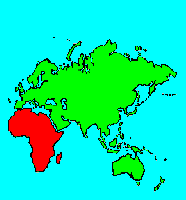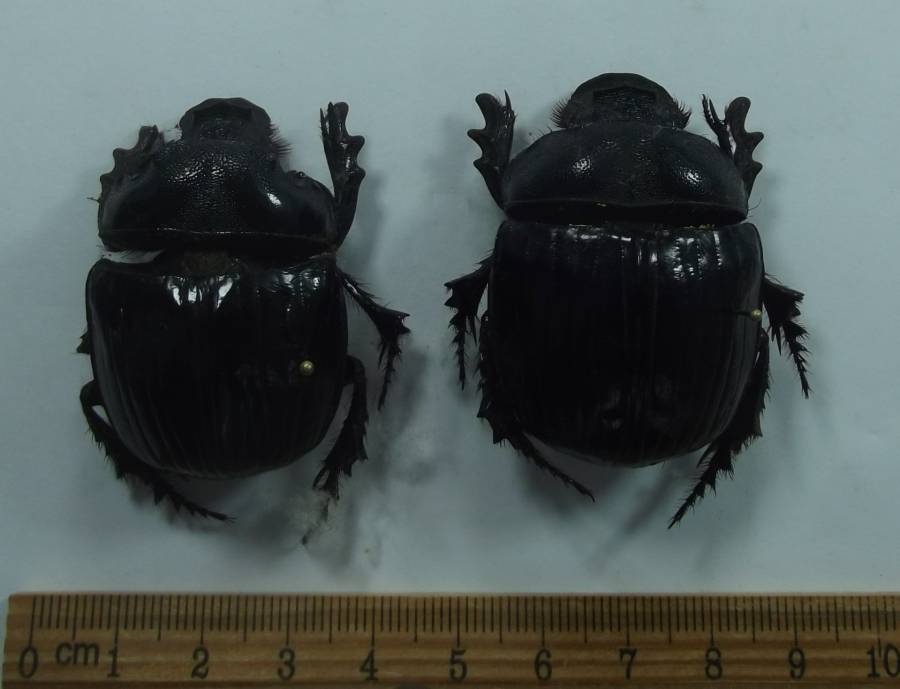SPECIES INFO
Heliocopris antenor is found in several different disjoint areas in Africa. There is a large area in NE Africa, two small areas in West Africa, a larger area covering Nigeria and north, and a final large area from the Congo south through Angola and east for a considerable distance. It appears in Cameroon that there are two different forms. This form has a large concave distance between the two points on the upper edge of the leading edge of the thorax. We have attempted to show this form with several different images taken at different angles.The Heliocopris genus is an old world genus of giant dung beetles. Most species show a variation from major males to minor males with considerable difference in the development of both the head horns and the leading edge of the upper thorax. There are about 50 described species. 45 are native to Africa. 4 are native to Asia, and one species is found on both continents. Most examples are within the range of about 3.0 to 5.0 cm, but some giants can approach 7.0 centimeters in length.
Dung Beetles, Sub-Family Scarabaeinae, are worldwide in distribution, but seemingly reach their greatest development as a family in the tropics.
Beetles (Order Coleoptera) are a diverse group of insects found throughout the world. They usually can fly and typically have four wings. Two of the wings are hardened (elytra) and serve as a body cover to protect the flying wings and abdomen. Beetles begin their life as a larvae or grub that goes through a metamorphosis that turns this worm-like creature into an adult with six legs and four wings. There probably are over 500,000 species of beetles in the world. However, that number is only conjecture as the United States does not have a complete list of its known species.
The United States has relatively few exotic beetles. However, countries like Brazil, Mexico, Ghana, Zaire, Malaysia, and Peru have many beautiful beetles.
Exotic beetles are such a fascination in Europe and Japan that they are collected much as coins are collected throughout the rest of the world.
Insects (Class Insecta) are the most successful animals on Earth if success is measured by the number of species or the total number of living organisms. This class contains more than a million species, of which North America has approximately 100,000. (Recent estimates place the number of worldwide species at four to six million.)
Insects have an exoskeleton. The body is divided into three parts. The foremost part, the head, usually bears two antennae. The middle part, the thorax, has six legs and usually four wings. The last part, the abdomen, is used for breathing and reproduction.
Although different taxonomists divide the insects differently, about thirty-five different orders are included in most of the systems.
The following abbreviated list identifies some common orders of the many different orders of insects discussed herein:
Odonata: - Dragon and Damsel Flies
Orthoptera: - Grasshoppers and Mantids
Homoptera: - Cicadas and Misc. Hoppers
Diptera: - Flies and Mosquitoes
Hymenoptera: - Ants, Wasps, and Bees
Lepidoptera: - Butterflies and Moths
Coleoptera: - Beetles
Jointed Legged Animals (Phylum Arthropoda) make up the largest phylum. There are probably more than one million different species of arthropods known to science. It is also the most successful animal phylum in terms of the total number of living organisms.
Butterflies, beetles, grasshoppers, various insects, spiders, and crabs are well-known arthropods.
The phylum is usually broken into the following five main classes:
Arachnida: - Spiders and Scorpions
Crustacea: - Crabs and Crayfish
Chilopoda: - Centipedes
Diplopoda: - Millipedes
Insecta: - Insects
There are several other "rare" classes in the arthropods that should be mentioned. A more formal list is as follows:
Sub Phylum Chelicerata
C. Arachnida: - Spiders and scorpions
C. Pycnogonida: - Sea spiders (500 species)
C. Merostomata: - Mostly fossil species
Sub Phylum Mandibulata
C. Crustacea: - Crabs and crayfish
Myriapod Group
C. Chilopoda: - Centipedes
C. Diplopoda: - Millipedes
C. Pauropoda: - Tiny millipede-like
C. Symphyla: - Garden centipedes
Insect Group
C. Insecta: - Insects
The above list does not include some extinct classes of Arthropods such as the Trilobites.
Animal Kingdom contains numerous organisms that feed on other animals or plants. Included in the animal kingdom are the lower marine invertebrates such as sponges and corals, the jointed legged animals such as insects and spiders, and the backboned animals such as fish, amphibians, reptiles, birds, and mammals.





